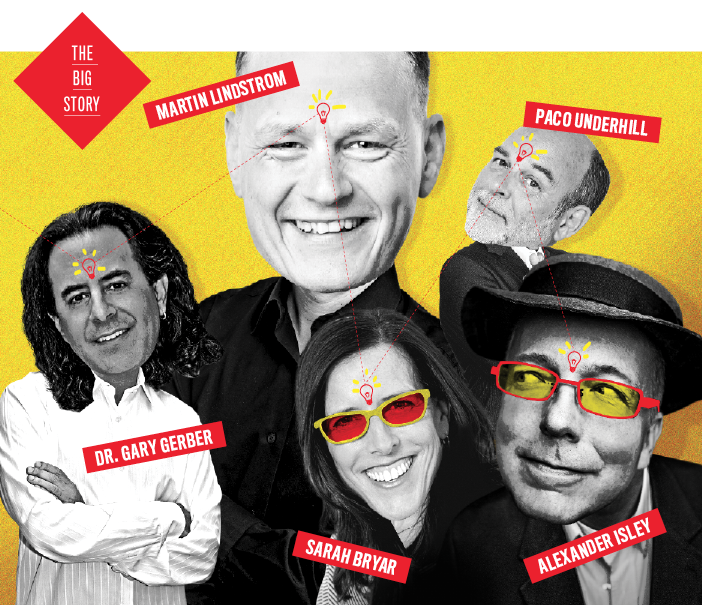
IF I OWNED AN EYECARE BUSINESS
Five well-known business minds imagine themselves in charge of their very own eyewear retail establishments
Think about the expression "a fresh pair of eyes." That’s exactly what INVISION was looking for when we invited a panel of nationally known business experts to tell us what big ideas they’d implement if they suddenly found themselves in charge of their own eyecare and eyewear business. Our hope? That their insights — plus those of several people in our field who don’t currently own their own shop — will inspire you to take a new look at your business — and begin seeing vision care as the true adventure it can be for you, your staff and your clients.
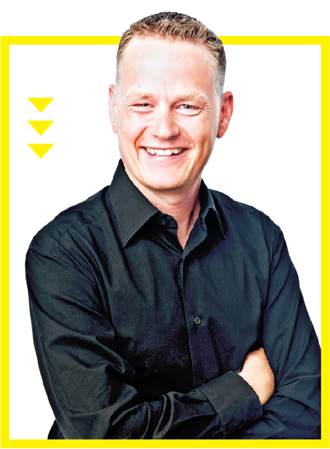
MARTIN LINDSTROM
Martin Lindstrom is the author of Buyology and Brandwashed. His clients include McDonald’s Corporation, PepsiCo, American Express, Microsoft, Nestlé, The Walt Disney Company and GlaxoSmithKline. He’s known for his pioneering work on using our five senses in branding, and he is a regular contributor to Fast Company, Time and NBC’s Today Show. Learn more at martinlindstrom.com
THESE DAYS, people want to buy everything online, don’t they? And since so many people are buying eyewear online, shouldn’t we expect every brick-and-mortar eyewear store to close its doors?
Hang on a minute! If customers prefer shopping for everything online, why did the number of fresh farmers markets increase by 17 percent last year? Do we really enjoy shopping for potatoes in the rain? Why did attendance at live concerts boom by 20 percent last year, when sound quality is so much better at home? And why has Warby Parker opened brick-and-mortar stores?
Advertisement
Traditional eyewear stores indeed have a bright future, but only if you recognize you can’t compete with online stores in price and volume.
I’m reminded of the scene from the movie Enemy of the State, in which Gene Hackman says, "In guerrilla warfare, you have to use your weaknesses as strengths. If they’re big and you’re small, then you are mobile and they’re slow." From the perspective of an eyewear shop, Hackman might say: "Your online competition is cheap and easy to use, but they’re also superficial and robotic — while you are engaging and personal."
If I owned an eyewear shop, the first thing I would do is to offer a high-quality eye-exam system. Beyond this, a trained expert would help every customer match frame designs to the personality he or she wants to display to the world, and match his or her personal style and color profile with the optimal frame shape and color. We’d also help people see how they’d look outside the store by projecting images of the customer wearing the new frames in various real-world-situations: a meeting room, over cocktails in a bar, etc.
We’d tap into Hollywood by projecting movie scenes, TV shows and music videos featuring admired performers, all wearing frames that are available in the store. We’d have a physical "touch and try" Top 20 chart, featuring today’s most popular eyewear designs.

And we’d offer an online voting system that allows customers to photograph themselves trying on different frames, beam the images to a select group of Facebook friends, and ask the friends to vote on which glasses they’d recommend.
Nothing is as personal as a pair of glasses. In addition to improving your eyesight, they project your image to the world and shape your personality. Of course you can buy eyewear online, but no online eyewear merchant can help you express your personality through this most personal of purchases.
Advertisement
As Gene Hackman said, "You capture their weapons and you use them against them the next time." The online players’ weapons are unlimited frames, cheap prices and easy accessibility, but your weapon can be quality advice from true experts as you sell perfect frames that will please your customers for years to come.

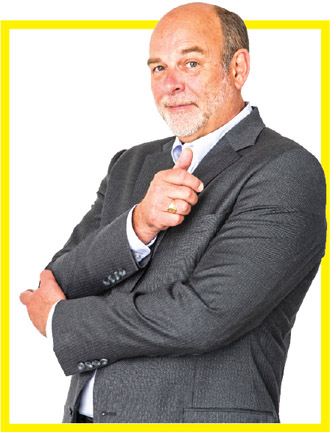
PACO UNDERHILL
Paco Underhill has worked with top eyecare brands across the world. He is founder of Envirosell, a leading consumer behavior research and consulting firm, and the author of Why We Buy: The Science of Shopping and What Women Want: The Science of Female Shopping.
Advertisement
IF YOU WANT to be a progressive independent eyecare professional, you need to be evangelical about helping people see well and look good. Your first challenge is recognizing the difference between the person who has been buying eyewear for decades and the customer who needs eyewear for the first time, whether for a child or their own aging eyes. So you ask right away: "Is this your first pair of glasses or not?"
Especially if it’s their first pair, you help curate their search. Ask questions. "Tell me something about how you use your eyes. Do you work in an office? Do you drive a truck?" Someone operating heavy equipment has different needs than a person working in advertising.
Once you have that conversation, you can give the customer an idea of the price points for a basic pair of glasses and a well-equipped pair. The sooner you can tackle that, the sooner you can avoid the sticker shock that comes when someone spends much more than they expected to when they walked in.
Start with the idea that eyewear and sunglasses are a fashion accessory. Especially for a mature woman, the opportunity to have several pairs isn’t a bad idea. Don’t ignore bundled sales, and don’t focus on selling one pair of glasses for $500 when you can offer a complete vision system of three pairs for $1,300.

It’s imperative to keep your store clean and your windows fresh. Allow people to browse and have a good set of mirrors, including an interactive mirror that can capture images as people try on glasses — especially helpful for people trying to see themselves without their prescription lenses. Record the images and play them back; that adds to the romance, enriches the process and builds comfort. It’s one thing to interact nose-to-nose sitting across a table; it’s another to offer "hip-to-hip" commentary standing next to a person.
If you are in a gateway city like New York, Miami or Los Angeles, the foreign tourist market is low-hanging fruit since optical services and products often cost less in the U.S. Put one sign in the window telling what languages you speak and another giving the turn-around time for glasses.
During the optical exam, be patient about telling people what you’re about to do. That sort of loving care is what builds people’s emotional relationship to you. And offer free adjustments, especially if you are on a busy street or mall concourse. I walked into a Lenscrafters one day with a pair of glasses that weren’t fitting well, and I was shocked when they told me the adjustment was free. But it meant they had a chance to have a conversation with me, and the next time I needed glasses, I returned.

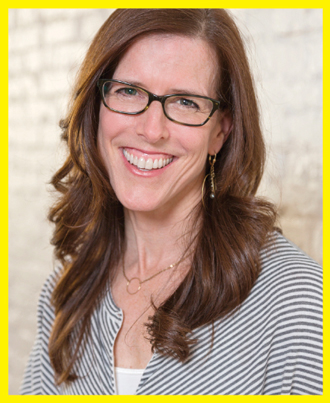
SARAH BRYAR
Sarah Bryar was CEO of Rivet & Sway, an online eyewear boutique for women that built a strong following in just two years (and a brand that lives on as part of the Glasses.com portfolio). Rivet & Sway experimented with offline retailing via pop-up beauty salon boutiques and had plans to open brick-and-mortar stores. Bryar — who has also worked at Amazon and Oracle — continues to explore the intersection between online and offline commerce and the possibilities of hybrid forms of retailing.
SHOPPING FOR GLASSES can be a daunting and mundane experience. Typical shops display frames by brand and style in a cookie-cutter approach, and there is little investment in creating a unique customer experience. Without direction, customers try on 20 to 30 frames to find the right pair. It’s time consuming and confusing, and after a frame is chosen, the customer is bombarded with lens options that can double or triple the cost.
In crafting an online boutique experience at Rivet & Sway, we learned that customers want to be inspired, they need direction, curation is essential, and the buying process needs to be straightforward and transparent. To help stimulate an emotional connection to Rivet & Sway, we obsessed over every detail of the customer experience: not only how people would navigate our selection, but details that built a consistent sense of who we were and how to shop with us — our imagery, our packaging, our stylists’ attitude, the responses from our customer service team. We knew we had 10 seconds to make an impression on our homepage. It’s no different when someone walks in the door of a retail store.
If I could design my ideal retail eyewear store, it would feel much more like an apparel boutique: bright and airy, clean lines, contemporary. Hip music would play in the background. Large-scale, fashion-forward photos of beautifully styled people wearing glasses would be displayed. Our front window would feature rotating outfit collages to demonstrate the power of glasses to complete a look — and make the connection that wearing glasses is fashionable and fun.
Near the entrance, a large touch screen would guide you through questions on size, fit, and style preferences. From your answers, you’d get a style profile: specific frame recommendations that could be printed in store and/or emailed for future reference. This first step could be completely self-service, empowering visitors to explore intelligently on their own. But our stylists would be trained to know when and how to offer help in a way that feels friendly, casual and informed.

The collection would be organized first by size, then by style and color, ranging from classic to edgy. Color coding would organize the collection by size so it’s easier to find frames that will fit. In the center of store, a "style-bar" with a high counter, bar stools and large mirrors would be staffed by a stylist who could offer feedback and fit advice or customize a selection of frames to try.
Once a customer was inspired to buy, our staff could help navigate a prescription and measure PD. Lens options would be simplified, with standard anti-glare and anti-scratch coatings. Check-out would be interactive and organic; our staff would carry iPads to complete the purchase efficiently and quickly.
Post-sale service would ensure a delightful experience through delivery and final fit. We would keep the customer informed on the status of her order via email. Glasses would be delivered for free to her home in beautiful packaging. If customers return to the store for a fitting, we would welcome them like old friends. We would offer to take their photo in their new glasses to share with friends. And we’d maintain relationships, encouraging our customers to visit us again via in-store events, exclusive previews of new collections and occasional promotions. We would want our store to feel like a destination, a place that’s fun to explore and visit again.


ALEXANDER ISLEY
Alexander Isley provides brand strategy, identity development and environmental design for clients including A/X: Armani Exchange, Aéropostale, Elizabeth Arden Red Door Spas, Jonathan Adler and Revlon. His company’s packaging and identity work has been featured in Time magazine’s “Best of the Year” issue and is included in the permanent design collections of the Museum of Modern Art and the Smithsonian Institution. Learn more at alexanderisley.com
MY VISION is terrible, and I’ve worn glasses since the fifth grade. So I’ve gone through a lot of frames. Over the years I’ve been a customer of small independently owned shops, big optical chains, online merchants, and I even once tried a big-box store. But my first experiences were the best.
Being that fifth-grade boy, I was always bashing my head into things, and my mom would take my glasses back to the optical shop several times a month for tune-ups. The nice guy in the back would carefully take his needle-nose pliers, straighten the temples and unbend the nose pads. He was always patient and never charged us for his work, and I remember how welcoming the place was. It was the only thing I liked about wearing glasses.
That’s why if I owned an optical shop, my focus would not be on the products. Sure, I’d have to have a good selection — that’s the price of entry. But it’s the ambience and customer experience that set you apart.
So I’d have a nice waiting area. Even if someone only sits for 30 seconds — or doesn’t sit at all — having furniture that is new and clean and not beat up signals that you care. Magazines would be two weeks old, max.
I wouldn’t bother with photos of people wearing glasses. When I see those, I eventually notice that the photos aren’t me, and I can’t relate. I’d rather just have a big mirror.
And this brings me to the biggest problem I have when buying glasses. When I take my glasses off to try on a new frame, all I really see in the mirror is a big, blurry head. This does not help my shopping experience. I try to get around this by taking an iPhone selfie and then putting my old glasses back on to see how I look. But the photo always seem a bit weird and distorted, even when I try not to make duck lips.
So in my shop I’d put in a webcam setup with a 30-second delay that would display the customer’s face life-size on a screen. People could see a real, virtual image of themselves at actual size and from different angles.
And I’d make sure my staff dresses up. My local optical shop clearly has a dress code, and it sets a tone that is matched by their service. They also charge a bit more, but I don’t mind. And being able to charge a bit more is not a bad thing.

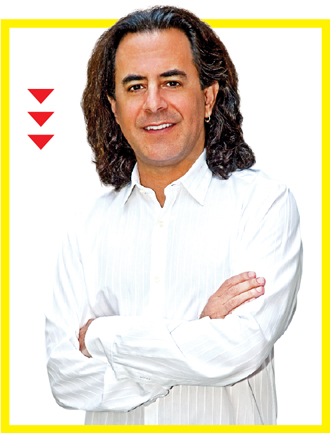
DR. GARY GERBER
Dr. Gary Gerber is the founder and Chief Dream Officer for The Power Practice, a company whose mission is to help doctors power their professional and personal dreams. Gerber is also a prolific writer, speaker, mentalist and magician who uses illusions to illustrate key points and entertain his audiences. He hosts The Power Hour, optometry’s only live talk radio show, at powerhour.info. When he’s not helping his clients power their dreams, he’s powering his own by playing keyboards in his band. Learn more at powerpractice.com
HISTORY REPEATS ITSELF and so does the essence of what powers successful businesses. Incorporating the tried-and-true — and augmenting that with your own unique industry-specific flair — is a sure way to succeed. The fundamentals of creating any successful business have remained the same since the first caveman sold the first wheel. So if I were to open a new practice, here are three things I’d do:
1. I’d have a plan, and I’d stick to it. While this sounds incredibly simplistic, as consultants, we rarely encounter new clients who have a firm, recorded, actionable set of goals, unwavering values and obviously permeating culture. Without all of those, you will wind up with a middle-of-the-bell curve practice and have a "business by default."
2. I’d hire amazing people, train them well and then let them do their jobs. The No. 1 lament I hear from doctors is, "My practice would be so much better if my staff were better." Well, if the problem is that obvious, why not fix it? The reason is because it’s very hard to fix and getting a rock star team is itself a big job. But, trust me: The best team wins. Put the requisite time and effort into cultivating superstars and don’t settle for average.
3. I’d listen to Sinatra and do it "my way." Build the practice you really want and pay little attention to external market forces. "Gary, you just don’t understand. What you’re saying may work for a donut shop or dry cleaner. But this is optometry! I have to deal with third-party payers, online retailers and big-box stores. Not to mention things like incredibly confusing government regulations! The guy down the street at the gas station doesn’t have to deal with any of that stuff!" Well, actually he does. In his case, it’s called OSHA and the EPA, and his staff shows up late for work, too. But that’s besides the point. If you go back to my first point — "have a plan and stick with it" — you can do it your way and have it your way.

For example, if your plan calls for having a take-home pre-tax net of $500,000 and you determine you’ll need to sell 2,000 pairs of $1,000 glasses to do that, you’ll have to say "no" to any third-party plan that doesn’t support your plan. You’ll have to open in a location that can support $1,000 eyeglass sales. If your next thought is, "If I’m not on the insurance plan, I won’t see enough patients," again, you’ll have to plan to succeed and determine what compelling reasons you’ll have in your brand proposition to convince prospective patients to see you — no matter what their insurance coverage — instead of a lower-priced competitor.
Finally, if I were opening today, I’d get help from others who have gone before me. Studies clearly show that those who open with the help of qualified and experienced business consultants and coaches do better than those who don’t.

| |
|
|
|
COMING UP NEXT YEAR
CATCH MORE "IF I OWNED" FEATURES IN 2015
|
| |
| |
Tom Mara
Radio visionary at
KEXP.org, with 1.7 million
YouTube views a week
If owned my own eyewear store, it would follow one simple rule: Bring the best artists in eyewear to greater public attention. Designers and creators of the best frames, lenses and accessories would inhabit my shop, tell their stories and showcase how they craft their creations. Naturally our customers would be enthralled, and why not?
Chris Wheaton
Totally ready to run
his own optical business
I’ve always thought of my store as if Charles Eames and Steve Jobs co-owned a speakeasy. When you walk into my shop, I want you to not feel like you are walking into an optical shop. I want you to feel like you’re entering your favorite bar or cafe; a place that inspires you and makes you feel relaxed and at ease.
Scott Ginsberg
"The Nametag Guy"
Approachability expert
We would be known for the story we tell, not the glasses we sell. In retail, telling a good story is the strategy that gets customers to pay attention and walk in the door. Our story would be about perspective, not vision. We would hire models and actors and raconteurs who could tell compelling stories and entertain our guests.
Andrea Learned
Leadership consultant
Co-author of
Don’t Think Pink
Our employees would include talented people from the community, even if they needed training in the optical world. Living and shopping locally means employees of all the nearby business can come to us and we to them.
Bob Phibbs
"The Retail Doctor"
Customer experience guru
I’d find out how customers like to see themselves. After all, glasses are a chance to start over again and be daring, dashing and decadent. So I’d organize my products in such a way that customers could find the frames that fulfill these wishes.
Addie and Shaun Bogart
Siblings who revel
in selling cool specs
We can put you in any frame, but you can only get your best vision with the best lenses and technology. You wouldn’t put retreaded tires on a new Ferrari, would you?
Matthew Hudson
Retail industry expert
with Rick Segel & Associates
I would merchandise by lifestyle, meaning "office," "home," "sport," and so on. Categories like these would add a visual reminder that you need different frames for different aspects of your life.
|
|
| |
|
|
NOTE: Know of someone you’d like to see featured in “If I Owned …”?
Email us at editor@invisionmag.com with your suggestions.